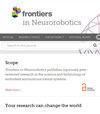A framework for neurosymbolic robot action planning using large language models
IF 2.6
4区 计算机科学
Q3 COMPUTER SCIENCE, ARTIFICIAL INTELLIGENCE
引用次数: 0
Abstract
Symbolic task planning is a widely used approach to enforce robot autonomy due to its ease of understanding and deployment in engineered robot architectures. However, techniques for symbolic task planning are difficult to scale in real-world, highly dynamic, human-robot collaboration scenarios because of the poor performance in planning domains where action effects may not be immediate, or when frequent re-planning is needed due to changed circumstances in the robot workspace. The validity of plans in the long term, plan length, and planning time could hinder the robot's efficiency and negatively affect the overall human-robot interaction's fluency. We present a framework, which we refer to as Teriyaki, specifically aimed at bridging the gap between symbolic task planning and machine learning approaches. The rationale is training Large Language Models (LLMs), namely GPT-3, into a neurosymbolic task planner compatible with the Planning Domain Definition Language (PDDL), and then leveraging its generative capabilities to overcome a number of limitations inherent to symbolic task planners. Potential benefits include (i) a better scalability in so far as the planning domain complexity increases, since LLMs' response time linearly scales with the combined length of the input and the output, instead of super-linearly as in the case of symbolic task planners, and (ii) the ability to synthesize a plan action-by-action instead of end-to-end, and to make each action available for execution as soon as it is generated instead of waiting for the whole plan to be available, which in turn enables concurrent planning and execution. In the past year, significant efforts have been devoted by the research community to evaluate the overall cognitive capabilities of LLMs, with alternate successes. Instead, with Teriyaki we aim to providing an overall planning performance comparable to traditional planners in specific planning domains, while leveraging LLMs capabilities in other metrics, specifically those related to their short- and mid-term generative capabilities, which are used to build a look-ahead predictive planning model. Preliminary results in selected domains show that our method can: (i) solve 95.5% of problems in a test data set of 1,000 samples; (ii) produce plans up to 13.5% shorter than a traditional symbolic planner; (iii) reduce average overall waiting times for a plan availability by up to 61.4%.使用大型语言模型的神经符号机器人行动规划框架
由于符号任务规划易于理解并可在工程机器人架构中部署,因此被广泛用于实现机器人自主性。然而,符号任务规划技术很难在现实世界的高动态人机协作场景中推广,因为在规划领域中,行动效果可能不是立竿见影的,或者由于机器人工作区的环境变化而需要频繁重新规划时,符号任务规划技术的性能较差。计划的长期有效性、计划长度和计划时间可能会妨碍机器人的效率,并对整个人机交互的流畅性产生负面影响。我们提出了一个框架,我们称之为 "Teriyaki",专门用于弥合符号任务规划与机器学习方法之间的差距。其原理是将大型语言模型(LLM),即 GPT-3 训练成与规划域定义语言(PDDL)兼容的神经符号任务规划器,然后利用其生成能力克服符号任务规划器固有的一些局限性。其潜在优势包括:(i) 由于 LLM 的响应时间与输入和输出的总长度呈线性关系,而不是像符号任务规划器那样呈超线性关系,因此随着规划领域复杂度的增加,LLM 具有更好的可扩展性;(ii) 能够逐个行动合成计划,而不是端到端合成计划,并且每个行动生成后可立即执行,而不是等待整个计划可用,这反过来又实现了并行规划和执行。在过去的一年里,研究界在评估 LLM 的整体认知能力方面做出了巨大的努力,并取得了一些成功。而 Teriyaki 的目标是在特定规划领域提供与传统规划师相当的整体规划性能,同时利用 LLMs 在其他指标方面的能力,特别是与短期和中期生成能力相关的指标,这些指标用于构建前瞻性预测规划模型。选定领域的初步结果表明,我们的方法可以(i) 解决 1,000 个样本测试数据集中 95.5% 的问题;(ii) 生成的计划比传统的符号规划器最多缩短 13.5%;(iii) 将计划可用性的平均总体等待时间最多减少 61.4%。
本文章由计算机程序翻译,如有差异,请以英文原文为准。
求助全文
约1分钟内获得全文
求助全文
来源期刊

Frontiers in Neurorobotics
COMPUTER SCIENCE, ARTIFICIAL INTELLIGENCER-ROBOTICS
CiteScore
5.20
自引率
6.50%
发文量
250
审稿时长
14 weeks
期刊介绍:
Frontiers in Neurorobotics publishes rigorously peer-reviewed research in the science and technology of embodied autonomous neural systems. Specialty Chief Editors Alois C. Knoll and Florian Röhrbein at the Technische Universität München are supported by an outstanding Editorial Board of international experts. This multidisciplinary open-access journal is at the forefront of disseminating and communicating scientific knowledge and impactful discoveries to researchers, academics and the public worldwide.
Neural systems include brain-inspired algorithms (e.g. connectionist networks), computational models of biological neural networks (e.g. artificial spiking neural nets, large-scale simulations of neural microcircuits) and actual biological systems (e.g. in vivo and in vitro neural nets). The focus of the journal is the embodiment of such neural systems in artificial software and hardware devices, machines, robots or any other form of physical actuation. This also includes prosthetic devices, brain machine interfaces, wearable systems, micro-machines, furniture, home appliances, as well as systems for managing micro and macro infrastructures. Frontiers in Neurorobotics also aims to publish radically new tools and methods to study plasticity and development of autonomous self-learning systems that are capable of acquiring knowledge in an open-ended manner. Models complemented with experimental studies revealing self-organizing principles of embodied neural systems are welcome. Our journal also publishes on the micro and macro engineering and mechatronics of robotic devices driven by neural systems, as well as studies on the impact that such systems will have on our daily life.
 求助内容:
求助内容: 应助结果提醒方式:
应助结果提醒方式:


